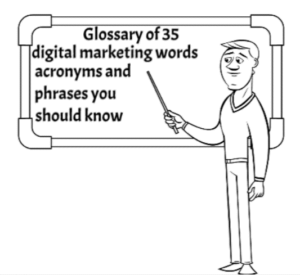
Alt text: brief, description of an image. Search engines look for the tags on images which are designed to assist individuals who are visually impaired
Average order value (AOV): The sum of individual order amounts divided by the number of orders
the sum of individual order amounts/ number of orders = AOV calculation
Breadcrumbs: Row of internal links at the top or bottom of the page allowing visitors to quickly navigate back to a previous sections
Cart abandonment: When a customer adds an item to a shopping cart, but doesn’t complete the purchase.
Chatbot: Software that responds to common customer questions, via list of pre-entered answer to common questions.
Conversion rate: The percentage of users or website visitors who completed a desired action, such as clicking on a link in an email or purchasing a product.
Conversions / Total Clicks x 100 = Conversion Rate Percentage
Cost per acquisition (CPA): The average cost of acquiring a potential customer
Total cost of conversions / Number of conversions = Cost per acquisition
Cost per click (CPC): The amount a marketer pays when someone clicks on their ad.
Cost per thousand impressions (CPM): The amount a marketer pays for every 1,000 impressions an ad receives
(cost of the ad campaign / number of impression received) x 1000
Cost per view (CPV): The amount a paid when a user watches a video ad for a minimum amount of time or interacts with it, such as when they click a link embedded in the video
Customer lifetime value (CLV): The average revenue generated per customer over a certain period of time
Customer retention rate: The percentage of customers that a company retains over a certain period of time
LTV = Average Order Value (AOV) x Purchase frequency
[(E-N)/S] x 100 = Customer retention rate
E is the number of total customers at the end of a given time period.
N is the number of new customers added within a given time period.
S is the number of existing customers at the start of the time period.
Digital marketing: Reaching consumers online through digital channels with the aim of turning them into customers.
Display ad: A visual ad format placed on websites or applications
E-commerce: Buying and selling of goods or services using the internet
Frequency: How many times an individual encounters an ad
Hypertext Transfer Protocol Secure (HTTPS): A method of transferring information over the internet that protects the integrity and confidentiality of data.
Impressions: The total number of times an ad appears on people’s screens
Indexing: The process of search engined saving and organizing website information to display in the search engine
Key performance indicator (KPI): Measurement used to gauge how successful a business is in its effort to reach their business or marketing goal
Keyword: A search term people use to find information, products, and services online
Keyword stuffing: The practice of loading a webpage with keywords or numbers in an attempt to manipulate a site’s ranking in the search results (something not to do)
Landing page: The first page a visitor encounters when they go to a website
Marketing funnel: A visual representation of the process through which people go from learning about a brand to becoming loyal customers
Meta description: Text that provides search engines with a summary of what the page is about
net profit / total revenue x 100
Organic search: Unpaid results a search engine produces when a search is performed
Rank: A webpage’s position in the search engine results pages (SERPs), which is determined by an algorithm
Return on ad spend (ROAS): How much revenue is gained versus how much was spent
(number of products sold X the cost per unit) / ad spend. = ROAS Roas
Marketing return on investment (ROI): Calculated by subtracting the marketing cost from the total sales growth and dividing the result by the marketing cost
(total sales growth during the period the campaign – marketing costs) / marketing costs = ROI
Paid results: Search results that advertisers pay to show whenever a user runs a search containing certain keywords
Search engine marketing (SEM): Generating traffic to a website through paid ads that appear in search engine results
Search engine optimization (SEO): A method of increasing the visibility of website pages organically through the use of search engines to attract more relevant traffic.
Search engine results pages (SERPs): Pages of results a search engine shows after a search was done.
Segmentation: Division of an organizations email subscriber list into smaller groups based on criteria and or demographics.
Sitemap: A file that provides information about the pages, videos, and other files on a site, and the relationships between them that search engines use.
Subdomain: A subset of a larger domain used to organize an existing website into a different page URL. For example if a domain is test.com a subddomain could be blog.test.com